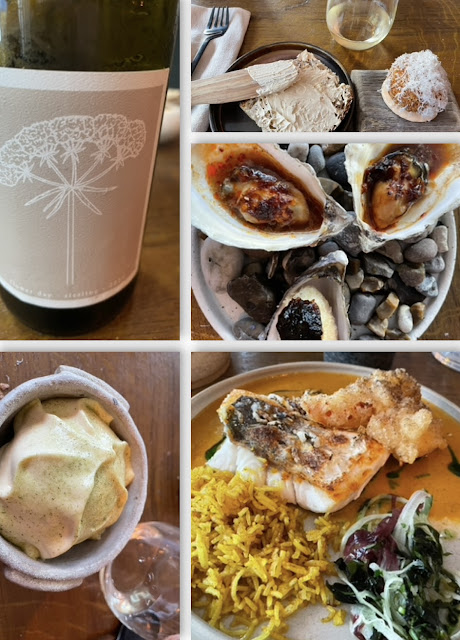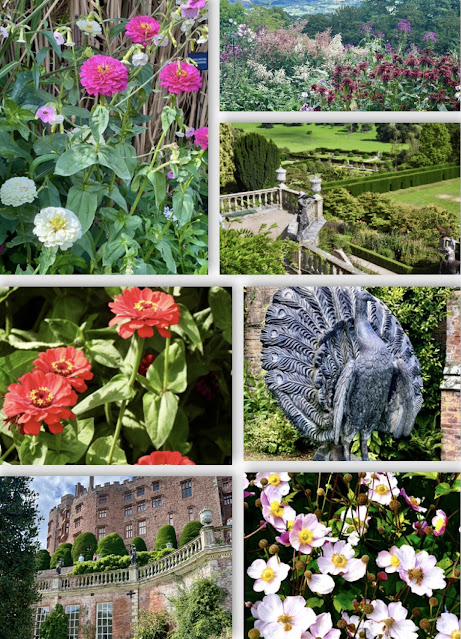It was time to move on to Cornwall, the southernmost part of the UK in the southwest of England. Finally we would be in the "tropics" by UK. standards. Truth to tell, it didn't feel tropical to us but it was better weather-wise than the trip to date.
On our way we stopped briefly in Topsham, a trendy town near Exeter, for a stroll around Fore Street to check out the shops selling clothing, pastries, seafood and more. We continued on to Exeter and had lunch at Rendevzvous. The Mezze board with artichokes, tomatoes, soft cheese stuffed peppers, humus, olives, bread, oil & balsamic was a great starter and we finished with roasted vegetables and chicken supreme.
After lunch it was a short walk to the Exeter Cathedral. The Cathedral is impressive. We moved on to check out the shops along Gandy & High Streets.
We arrived in Padstow in the late afternoon and got settled into St Edmund’s House, a Rick Stein property near his renowned Seafood Restaurant.
We later discovered a nice little wine bar, 17 Duke Street. Over the course of our stay we visited it 3 times for:
- glasses of bubbly
- glasses of wine with crisps, and prosciutto
- dips and bread with charcuterie and Garnatxa wine
We dined at Prawn on the Lawn for Pat 's B'day. It is a tiny hole in the wall with very fine seafood and wine. We started with Billecart-Salmon Champagne; we followed that with the roast padron peppers and sourdough bread with seaweed butter for appetizers; the mains were seared tuna and cod with herbs & pine nuts; and we finished with lemon mouse, with cherry sauce & burnt white chocolate.
A very fine meal. We had enjoyed conversing with a young couple and their kids throughout the meal. They left shortly before we did. And, to our surprise, when we asked for out bill, we learned that they had paid for our Billecart-Salmon! We were stunned (and delighted). Pretty sweet.
While in Padstow we visited an interesting "European Lobster" hatchery. Female lobsters with eggs are dropped at the hatchery and after the eggs are hatched the lobster is returned to the fisherman. The benefit of this process is there are more survivors than in the wild. A great benefit to all! The Lobsters are very similar to those in Maine with the two large claws.
We walked around the the harbor and along the beach opposite the ritzy town of Rock. The ferries to Rock use the pier or beach for landing, depending on the tide.
We had a tour of the ruins at Tintagel of King Arthur fame. From about the 5C to 7C AD it was an important stronghold.12C writer Geoffrey of Monmouth named it in his History of the Kings of Britain as the place where King Arthur was conceived with the help of Merlin. At the same time, Cornish and Breton writers linked the love story of Tristan and Iseult with Tintagel.
Built half on the mainland and half on a jagged headland projecting into the Cornish sea, it has fine coastal views.
We wandered around Port Isaac, a small, picturesque coastal beach town
We stopped at for lunch in Wadebridge where Bellini's Pizza and Carpaccio filled the bill. We also walked around the town looking at the shops.
While we were planning the trip we decided we wanted to dine at Rick Stein's Seafood Restaurant for our Anniversary. Even then it was difficult to secure reservations. But once we had booked one of his hotels, we were in for dining.
We started with glasses of Rick Stein's Blanc de Blancs Champagne. Very nice. As a starter we split a Hake Piperade with peppers, Serrano ham, onion, garlic, tomato and an olive oil and lemon sabayon. For the mains we chose the Troncon of Turbot with Hollandaise Sauce and the Whole Dover Sole meunière with Buttered potatoes and Courgette Fritti as sides ...all accompanied with a Chablis Premier Cru (which we had to pay for ourselves!) The Courgette Fritti were great! Who would have thought that would work?
We finished with a Port and a Sherry to accompany our Hot Chocolate Fondant.
The next morning at breakfast Pat just had to try one of her favorites. Sardines. She reports they were as good as ever.
Exploring the territory east of Padstow we visited Polpero where we wandered down narrow streets to the dock area. Looe, was a larger, more touristy, and had significant shopping and restaurant options. Below see Polpero in top 3 images plus the fragon. Rest are of Looe, including cornish pasties (Lamb & Mint, Cheese & Bacon, Pork & Apple).
Cotehele, a rambling granite and slate-stone manor house little changed in over 5 centuries, was a serene change of pace. The furnishings and gardens gave us plenty to photograph.
On our way to St Ives we visited the Eden Project a complex that is dominated by two huge enclosures consisting of adjoining domes that house thousands of plant species, and each enclosure emulates a natural biome. The larger of the two biomes simulates a rainforest environment (and is the largest indoor rainforest in the world) and the second, a Mediterranean environment. Plus it also has an outside botanical garden and separately an impressive Zip Line over the complex. Lots of green and color inside and outside the domes.
After an ice cream we continued on toward St Ives. We stopped next at the Lost Gardens of Heligan, an amazing garden and Play Meadow. Neglected from WWI until 1990, it then became Europe's largest garden restoration project. The gardens include highly productive flower and vegetable gardens, an Italian garden, and a wild area filled with subtropical tree ferns called "The Jungle". The gardens also have two figures made from soil, rocks and plants known as the Mud Maid and the Giant's Head. We walked the Woodland Walk and the Boardwalks through through the Jungle of exotic plants. Then we visited the farm with rare and heritage breeds (sheep, pigs, poultry, cattle and horses).
St Ives is a very pleasant town and the Boskerris Hotel was well located and our room very spacious. We dined quite well:
- At Ardor visit # 1 we had a Rioja to go with Calamari Fritti, Jamon Croquettes, Patatas Bravas, and Pork
- At Ardor visit # 2 we had a Garnatxa to go with Grilled Pita and a trio of Greek Dips, and a charcuterie board
- For lunch at St Eia we we enjoyed pate, beans, bread & butter, lardo with Cote du Rhone & Garnatxa
Bellaroma Agency who arranged 2/3 of our trip treated us to a dinner at One Fish Street. They offer a fixed menu with wine pairings.
- Bread and Marmite butter (excellent)
- Oysters not our favorite, done 3 ways
- Hake
- Strawberry dessert
We toured around Land's End, the most southern-western point of the UK including stops at Cape Cornwall, The Minack Theatre, Penzance (lunch), and St Michael's Mount.
We found Cape Cornwall to be a more deserted space to view the southern reaches of the UK than the more famous and touristy Land's End town itself. In general, the area is very picturesque (but once again, it is likely more picturesque in the sun).
A little history lesson: during the 18C Cornwall was the mining center of the world producing tin and copper. We passed numerous Tin Mine shafts and an Engine House (housed the water pumping engines or winding engines serving the mines below).
During the Bronze Age around 2,500BC, Cornwall was noted for the building of enigmatic ceremonial and burial monuments that still dot the landscape.
The Minack Theatre is an open-air theatre built into a rocky granite outcrop in Porthcurno Bay. With grass covered seats it is surrounded by gardens and the stage has an ocean backdrop. The creation of the theatre was begun by Rowena Cade in the 20's and 30's and has had continuing improvements throughout its existence.
There is an exhibit about how the property was used during WWII ...As with many other buildings the Minack was used as a defense facility during the World War II. The theatre had to be rebuilt after the war and was reopened in 1951.
St Michael's Mount, castle and gardens are on an Island near Penzance. The architecture and decor in the castle are worth the trip and the gardens are a nice bonus, even in the rain. Access by boat , or you can walk but only at low tide (you can see a hint of the path in the third photo down on the right).
Our final day in St Ives we wandered around town taking in the:
- Tate Museum - 20C / modern art, local artists (overlooks the beach)
- Barbara Hepworth Museum and sculpture garden - carvings & sculptures
- Beach - tents and wind screens a real day out with swimming & picnics
- Shops













































